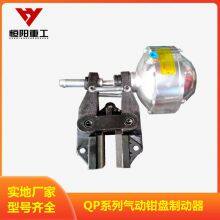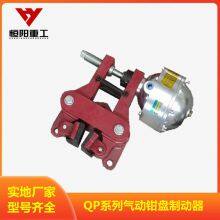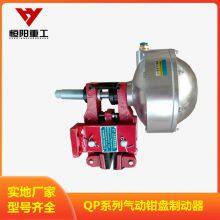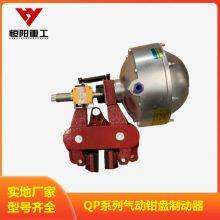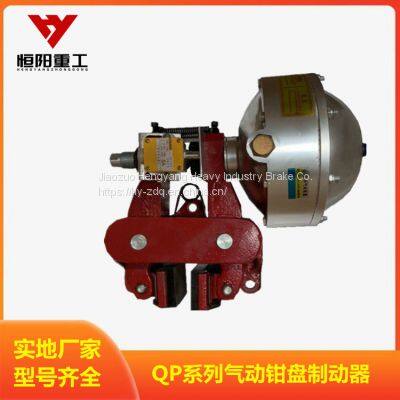Hengyang Heavy Industry Pneumatic Caliper Disk Brake CQP38B-A Asbestos Free Brake Liner
3) Inspection of brake disc surface damage
Every time the friction plate is replaced, it is necessary to check the brake disc for grooves and cracks. A in Figure 4 is the inspection and maintenance requirements of the friction disc brake
The items listed in Table 1 should be checked at least every 3 months. The recommended inspection cycle is a requirement, and depending on the usage of the vehicle, it may be necessary to inspect the brake system more frequently.
The wear of the friction plate must be regularly visually inspected, such as checking the friction plate every time the tire pressure is checked, or checking it every 3 months. Regularly check the wear limit of the brake disc and friction plate. When the brake disc and friction plate wear to the specified thickness, the braking efficiency will decrease and must be replaced immediately. When the friction plate is burnt or contaminated with oil, it must also be replaced immediately. The friction plate must be replaced on a shaft basis, not on a single piece basis, and must use friction plates produced by the manufacturer.
1) Inspection of friction plates
Before starting the inspection, it should be confirmed that the service brake, parking brake, and temporary parking brake for passenger cars are not applied, and the vehicle should be secured and the wheels should not move.
Remove the sealing cap and use a ratchet wrench to rotate the adjusting bolt counterclockwise to loosen the friction plate. Remove the friction plate. As shown in Figure 2, measure the distance from the bottom surface of the brake block (including the bottom plate) to the friction surface with a Vernier scale. The allowable thickness (including the bottom plate) is 11mm. It is required to select 4 points with uniform circumferential distribution for measurement, and avoid areas with severe burrs and wear.
Check whether the friction plate is evenly worn. Use a Vernier scale to select 8 points that are evenly distributed in the circumferential direction (avoid the severely worn part) for measurement. The allowable unevenness is 1mm. If the wear is uneven, check whether the sliding function of the brake caliper on the sliding pin is normal, whether there is dust between the friction plate bottom plate and the integral push plate, and whether the clearance adjustment function of the self-adjusting mechanism is normal.
Attention: When replacing the friction discs, all friction discs of the two brakes on the same axle must be replaced simultaneously, and the new friction discs to be replaced must be selected from the original accessories specified by Heavy Duty Truck. Due to light braking, the wear of the inner friction plate may be more than that of the outer friction plate.

Send Inquiry to This Supplier
You May Also Like
-
Hengyang Heavy Industry Pneumatic Caliper Disc Brake CQP12.7-A Non Asbestos Brake LinerUS$ 2200 - 2500MOQ: 5 Units
-
Hengyang Heavy Industry Pneumatic Caliper Disc Brake CQP12.7-B is Easy to ReplaceUS$ 2200 - 2500MOQ: 5 Units
-
There is no Need to Adjust the Power Source of Hengyang Heavy Industry Pneumatic Caliper Disc Brake QP12.7-BUS$ 2200 - 2500MOQ: 5 Units
-
Hengyang Heavy Industry Pneumatic Brake QPL12.7A-A Brake Pad Easy to ReplaceUS$ 2200 - 2500MOQ: 5 Units
-
Hengyang Heavy Industry Short Rope Catcher DSZ Series Has a Simple Structure and Reliable PerformanceUS$ 9500 - 15000MOQ: 5 Units
-
DSZ Series Broken Rope Catcher, Easy to Operate by Hengyang Heavy IndustryUS$ 9500 - 15000MOQ: 5 Units
-
Hengyang Heavy Industry DSZ Series Broken Rope Catcher With Stable BrakingUS$ 9500 - 15000MOQ: 5 Units
-
Hengyang Heavy Industry DSZ Series Broken Rope Catcher Has a Long Service LifeUS$ 9500 - 15000MOQ: 5 Units
-
Hengyang Heavy Industry Broken Rope Catcher DSZ Series Has a Compact Structure and Beautiful AppearanceUS$ 9500 - 15000MOQ: 5 Units
-
Hengyang Heavy Industry's DSZ Series Setting Limit Switch for Rope Breaking and Catching BrakesUS$ 9500 - 15000MOQ: 5 Units


